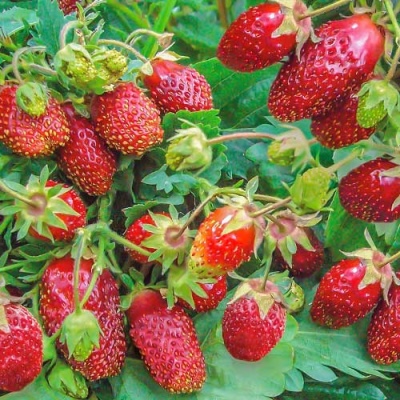
- Authors: Russia
- Taste: sweet and sour
- Weight: 20-30 gr
- Yield rate: high
- Yield: up to 250 grams per bush
- Ripening terms: medium
- Advantages: good keeping quality
- Description of the bush: tall, spreading
- Berry color: burgundy red
- Winter hardiness: winter hardy, - 30 ° С
Candied Muscat is a variety of Russian dwarf breeders. The variety is characterized by delicious versatile berries that taste very good when fresh and make delicious jam. Let's figure out how difficult it will be to grow this variety in a summer cottage.
Description of the variety
The bush is sprawling, high, reaches a height of 20-30 cm. This species is characterized by abundant flowering. During this period, the site is densely covered with beautiful white flowers, raised high above large leaves. Tall flower stalks provide good ventilation for the fruit.
Ripening terms
Candied Muscat is a medium-ripening variety with fruiting period in June-July.
Yield
The variety is very high-yielding. From 1 bush, you can get up to 250 g of the crop.
Berries and their taste
The berries are burgundy-red in color and round-conical in shape. The mass of the berries is 20-30 g. Their taste is sweet and sour, pleasant, the aroma contains spice, strawberry nutmeg.
Special attention should be paid to the pulp, which contains trace elements and vitamins E and C. It is very dense, and this provides the berries with excellent marketability, long shelf life and the ability to endure transportation.
Growing features
Candied Muscat needs a simple classic care, but some stages of cultivation deserve special attention.
- This variety is very hygrophilous, so it is required to provide the culture with regular watering, especially during drought periods.
- When growing, it is imperative to apply fertilizers: before and during flowering, as well as after fruit setting.
- It is important to ensure periodic removal of the antennae, otherwise the plant may become a victim of gray rot. Leave only those copies that are suitable for reproduction.




Site selection and soil preparation
When planting a crop of the presented variety, observe the following rules:
- select an area for planting that is well lit by the sun, however, this species is not afraid of shading;
- the optimal time for planting is March-May or August-October (properly planted seedlings adapt well to new conditions in both spring and autumn);
- give preference to soil with light or medium texture and acidity of 5.0-6.5 pH;
- before planting, add 5 kg of organic matter and 30-40 g of mineral fertilizers per 1 m2 of the plot, then dig up the garden bed;
- there is a growth bud on small seedlings, which cannot be buried during planting: leave it on the same level with the ground;
- follow the 40x40 cm planting pattern.

Pollination
This variety has bisexual flowers, which means that it is able to pollinate on its own and does not need artificial pollination.

One of the important techniques in strawberry care is feeding. Regular fertilization guarantees a rich harvest. There are several different ways to feed strawberries, and each of them is designed for a specific period of plant development. During flowering, fruiting and after it, feeding should be different.
Frost resistance and the need for shelter
This plant is unpretentious to frost, which can withstand temperatures up to -30 degrees, so the bush does not need shelter for the winter.

Diseases and pests
Powdery mildew and gray rot practically do not affect this variety, therefore preventive treatments for ailments are not needed, however, this earthworm is often attacked by a strawberry mite. You can get rid of it manually, but if the plantation is large, it will take a long time. Therefore, you can use agents that have an insectoacaricidal effect, but do not use them during the fruiting period. From folk remedies, onion peel tincture, a decoction of tomato leaves or a garlic decoction are effective.

Strawberries are often subject to many dangerous diseases that can seriously undermine their condition. Among the most common are powdery mildew, gray mold, brown spot, anthracnose, and verticillosis. Before buying a variety, you need to inquire about its disease resistance.
Reproduction
You can breed the plant with rosettes. They are rooted on a young mustache. Reproduction by dividing the bush is also possible: for this method, specimens at the age of 2-3 years are chosen.
Growing seedlings from seeds is considered troublesome, so young shoots are bought in nurseries. However, experienced gardeners who do not trust the quality of nurseries can try to grow seedlings on their own, and then you can be sure that a real author's Candied Muscat is developing on the site. To do this, the appeared bushes need to be planted in a heated greenhouse, watered and organize a calm and warm early spring for them. The surviving specimens will become a model for the purity of the variety.
Reviews
The gardeners who managed to grow this dugout highly appreciated the taste and color of the berries.Also, summer residents are attracted by the simple care and appearance of the site during flowering. Among the shortcomings, the troublesome cultivation of varieties from seedlings is noted.



















































































